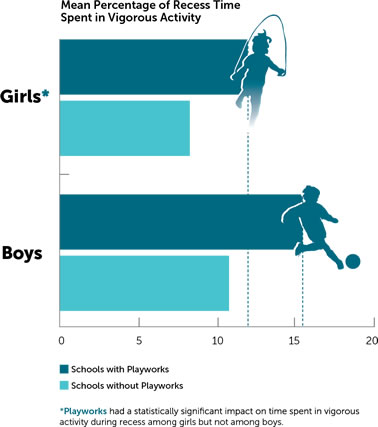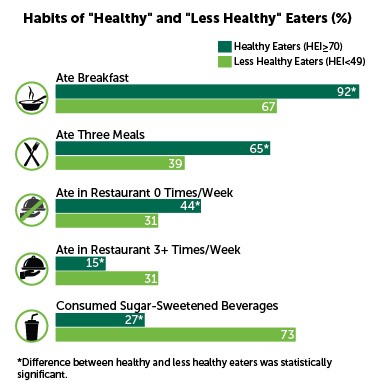National Nutrition Month spotlights the essential role that a nutritious diet and physical activity play in the health and well-being of all Americans. For more than three decades, Mathematica Policy Research has analyzed federal nutrition assistance programs designed to reduce hunger and promote healthy, active lifestyles among low-income people. We have also examined the dietary and physical activity habits of Americans to build a better understanding of how to encourage healthy choices and reduce childhood obesity. This summary is the last in a four-part series that describes Mathematica's research on nutrition policy issues in recognition of National Nutrition Month.
Community Partnerships Key to Addressing Obesity
The childhood obesity rate has tripled in the U.S. over the past four decades. Reversing this trend will require coordinated, collective efforts from diverse stakeholders in health care, public health, local government, schools, child care, and community-based organizations. One initiative focused on this goal was the Healthy Weight Collaborative, a project of the National Institute for Children’s Health Quality. This collaborative brought together 50 community teams to implement and test a “change package”—a set of six evidence-based and promising strategies to prevent and treat obesity in children and families. Mathematica’s formative evaluation of the collaborative showed that community teams can successfully work together to put these kinds of strategies into action.
 Promoting Physical Activity Through Recess
Promoting Physical Activity Through Recess
Schools have an important role in shaping children’s physical activity habits. Recess is a unique opportunity for children to play and exercise, yet research has shown that even when time is available for recess, environmental and social factors can deter children’s activity. Playworks, a school-based program that promotes physical activity among school-age children, places full-time coaches in low-income schools to orchestrate play throughout the day via recess activities, in-class games, and junior coach programs. In the first-ever randomized controlled trial of Playworks, Mathematica found that more teachers in Playworks schools reported that their students engaged in vigorous physical activity during recess than teachers in non-Playworks schools. We also found that Playworks significantly increased some aspects of girls’ physical activity, although there was no similar impact on boys.
Building Evidence on What Works to Prevent Childhood Obesity
Efforts to build an evidence base about successful strategies for curbing childhood obesity have been constrained by a lack of consistency in the measures used to test such strategies. To address this problem, the National Collaborative on Childhood Obesity Research (NCCOR) has sought to promote the use of common measures in this field. Mathematica helped NCCOR develop its Measures Registry, a searchable database of diet and physical activity measures relevant to childhood obesity research.
Mathematica staff have also helped build the evidence base through their work on expert advisory groups related to childhood obesity. Recently, senior fellow Ronette Briefel participated in an Institute of Medicine committee that developed a plan to measure the nation’s progress in obesity prevention. The committee’s recommendations focused on ways to increase the monitoring and evaluation of obesity prevention efforts and to widely disseminate any promising practices.
Eating Habits Develop Early
Dietary patterns develop early in life, so the sooner healthy eating habits can be established, the better. To explore this issue, Mathematica conducted the landmark Feeding Infants and Toddlers Studies (FITS) in 2002 and 2008. These studies assessed the diets of infants, toddlers, and, in FITS 2008, preschoolers. The findings showed some improvement in children's eating habits from 2002 to 2008—including significant reductions in the percentage of infants and toddlers who consumed desserts or candy, sugar-sweetened beverages, and salty snacks. However, the diets of young children remained less than optimal. The eating habits of toddlers and preschoolers mirrored common dietary problems seen in older children and adults, and these patterns emerged more strongly as children grew older.
Dietary Patterns of "Healthy" and "Less Healthy" Eaters

USDA's Food and Nutrition Service (FNS) is committed to improving the diet of low-income populations. In addition to providing financial benefits to ensure access to healthy foods, FNS programs provide nutrition education to guide healthy choices. Mathematica's research has helped FNS develop nutrition education strategies by providing insight into the dietary patterns of low-income populations. Using data from the National Health and Nutrition Examination Survey, we examined the demographic characteristics and eating habits of "healthy" and "less healthy" eaters, who were defined by their scores on the Healthy Eating Index (HEI)–2005. We found that less healthy eaters were more likely to be men, African Americans, teenagers, smokers, or people with very low food security. Less healthy eaters were also less likely to eat breakfast or three meals per day, and they were more likely to eat in restaurants and to consume sugar-sweetened beverages. Their total caloric intake also included a larger share of snack foods and foods that contained solid fats and added sugars. Even among healthy eaters, there was room for improvement. These findings suggest that FNS should customize its nutrition education efforts to specific subgroups; find ways to reduce the intake of high-calorie, low-nutrient foods such as sugar-sweetened beverages, high-fat dairy, and desserts; and promote healthier alternatives.
The Link Between Food Expenditures and Diet Quality
The goals of the Supplemental Nutrition Assistance Program (SNAP) are to ensure that low-income households do not go hungry and that they have access to a nutritious diet. Although research has shown that participation in SNAP leads to higher spending on food, there is little evidence that the increase in spending leads to a healthier diet. To bridge this gap in our knowledge, Mathematica examined the relationship between food expenditures and diet quality among SNAP participants and other low-income households. The findings showed that higher spending on food led to an increase in overall diet quality, but the improvement was small and may not be proportional to the additional spending. We did, however, find that improvements in diet quality were larger for certain food subgroups—particularly fruits and vegetables—suggesting that it may be worthwhile to promote certain types of foods in efforts to improve diet quality.
Mathematica's Experts Contribute to Development of Expanded Dietary Guidelines
Mathematica's nutrition experts Mary Kay Fox and Ronette Briefel are serving on two working groups under the "B-24/PW" project, which is jointly sponsored by USDA and the Department of Health and Human Services. The purpose of the project is to identify and organize scientific evidence to inform the expansion of the Dietary Guidelines for Americans to include guidance for children from birth to 24 months of age and pregnant women.
Participant Characteristics and Patterns of Participation
For almost three decades, Mathematica has given policymakers and program administrators critical information about how SNAP operates and whom it serves. Read our most recent reports on SNAP participant characteristics and program dynamics. Mathematica has also developed an interactive tool that compares SNAP participation and key economic indicators over time, as well as SNAP eligibility and rates of participation in 2012, by state.
Understanding How Proposed Policy Changes May Affect SNAP
Mathematica's research has also helped policymakers assess the impacts of potential changes in SNAP policies. In the early 1990s, we assessed the effect of substituting a cash transfer for food stamps. We found that families receiving cash benefits spent less on food than families using food stamps did. Our estimates indicated that 18 to 28 cents less of each benefit dollar was spent on food when cash transfers replaced food stamps.
In the ensuing years, Mathematica has developed sophisticated microsimulation models for the U.S. Department of Agriculture to use in estimating the effects of proposed policy changes on SNAP eligibility, participation, and benefits. Mathematica recently used these models in an analysis for the Pew Charitable Trusts and the Robert Wood Johnson Foundation. We simulated the consequences of 2014 Farm Bill proposals from the House and Senate, finding that 12 percent of SNAP participants would have lost eligibility under the House proposal, and another one percent would have seen their benefits reduced.
Mathematica has also evaluated a number of demonstration projects designed to test potential changes to administrative procedures in SNAP to improve efficiency and/or access. In a recent study, Mathematica assessed six pilot programs designed to increase access to SNAP among older adults and the working poor—two groups whose participation in the program has historically been at lower rates. We found that two of the pilots successfully increased SNAP participation among eligible low-income older adults. Both of these pilots featured a simplified application process and focused on people who participated in other government programs and were likely to be eligible for SNAP as well.
Providing Evidence for Decision Making
The House Committee on Agriculture is currently undertaking a full-scale review of SNAP. Findings from Mathematica's research can inform this review and future discussions about potential changes in the program. In recent testimony to the Subcommittee on Nutrition, Karen Cunnyngham and James Mabli described how Mathematica's research can help policymakers gain a deeper understanding of the people who depend on SNAP and how the program responds to changing economic conditions. Read Cunnyngham's written testimony here; read testimony coauthored by Mabli here.
For more about our recent SNAP studies, click here.
Mathematica to Lead Two Major Evaluations of Federal Nutrition Assistance Programs
National Nutrition Month spotlights the essential role that a nutritious diet and physical activity play in the health and well-being of all Americans. For more than three decades, Mathematica Policy Research has studied federal nutrition assistance programs designed to reduce hunger and promote healthy, active lifestyles among low-income individuals. We have also studied the dietary and physical activity habits of Americans to better understand how to encourage healthy choices.
In recognition of National Nutrition Month, we present a four-part series summarizing our research on an array of nutrition topics. In this first summary, we focus on two new contracts with the U.S. Department of Agriculture's Food and Nutrition Service. In both of these congressionally mandated evaluations, we will use rigorous research methods, including randomized controlled trials, to assess the impact of innovative strategies that address critical issues affecting Americans who depend on federally funded nutrition assistance programs.
Evaluation of the Supplemental Nutrition Assistance Program (SNAP) Employment and Training (E&T) Pilots
This evaluation will test innovative strategies for increasing employment and earnings among SNAP participants and reducing their dependence on SNAP and other public assistance programs. The study was mandated in the 2014 Farm Bill, which authorized grants for up to 10 pilots (demonstration projects). The 10 pilots will offer diverse services and target different groups of SNAP participants in a variety of geographic locations. For some pilots, participation is mandatory, and for others, it is voluntary. The centerpiece of the evaluation is a random assignment impact analysis, which will give policymakers and program operators insight into effective strategies for increasing employment and earnings, decreasing public assistance, and positively influencing other outcomes of interest, including food security, health, and housing. The impact analysis will also help us understand whether any of these outcomes vary for different types of SNAP participants.
In addition, the evaluation will include (1) an implementation analysis that will document the operation of each pilot and provide context for interpreting and understanding observed impact, both within and across pilots, (2) a participation analysis that will examine the characteristics and service paths of pilot participants and control group members, and determine whether the pilots, the services they offer, and/or the requirements they impose affect individuals' decisions about whether to apply for SNAP, and (3) a cost-benefit analysis that will estimate the return on each dollar invested in providing E&T services.
The 10 pilots should get underway in April 2016. This is a seven-year, $31 million evaluation, with annual reports due to Congress through 2021. Findings will be presented in interim and final reports available in 2019 and 2021, respectively. Several organizations are collaborating with Mathematica on this important work, including MDRC, Insight Policy Research, Kone Consulting, and Decision Information Resources.
The Evaluation of Demonstration Projects to End Childhood Hunger
This evaluation will test innovative strategies to reduce hunger in low-income households with children. The study was mandated in the Healthy Hunger-Free Kids Act of 2010 and will include five demonstration projects that target areas or populations with elevated levels of childhood food insecurity. The strategies to be tested may include enhanced SNAP benefits for eligible households with children; enhanced benefits or innovative program delivery models for meals and snacks provided in schools or child care settings; and strategies that target other federal, state, or local assistance programs. The evaluation will include a rigorous impact analysis of each demonstration project as well as implementation and cost-effectiveness analyses, and will facilitate cross-site comparisons. The primary goal is to reduce the prevalence of food insecurity among children. The evaluation will also examine the demonstration projects' impact on participation in nutrition assistance programs, as well as food shopping and spending. This is a four-year, $10–$15 million evaluation, with annual reports due to Congress through 2018.
A Leader in Informing Nutrition Program and Policy Decisions
Mathematica is a leader in evaluating programs and policies to ensure healthy, adequate diets for all Americans. We have studied all the major U.S. food and nutrition assistance programs, including SNAP, school meal programs, and the Special Supplemental Nutrition Program for Women, Infants, and Children. Findings from our research have informed major policy decisions for over 30 years.

